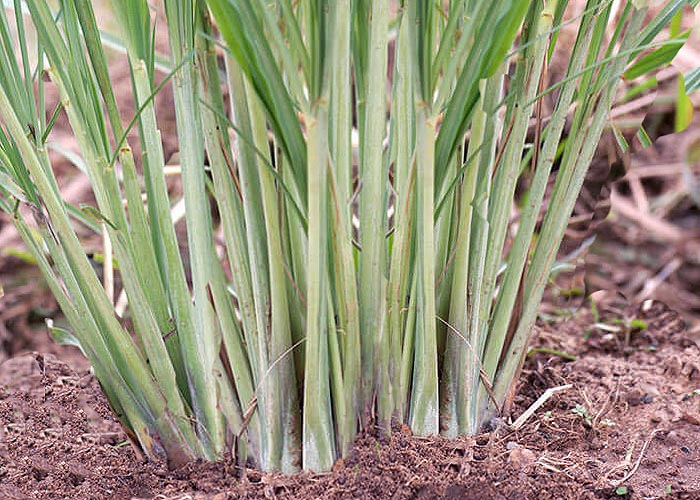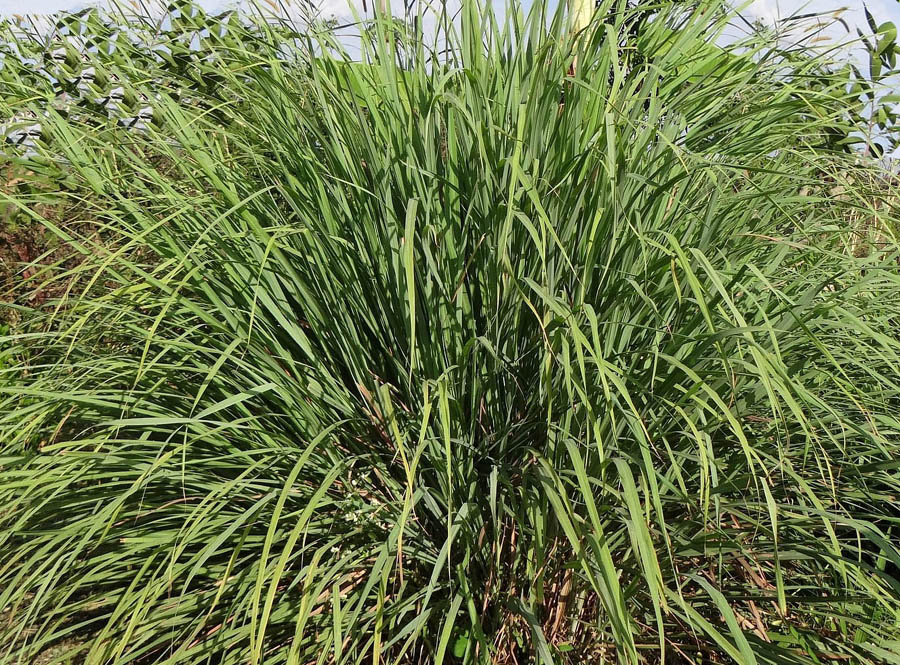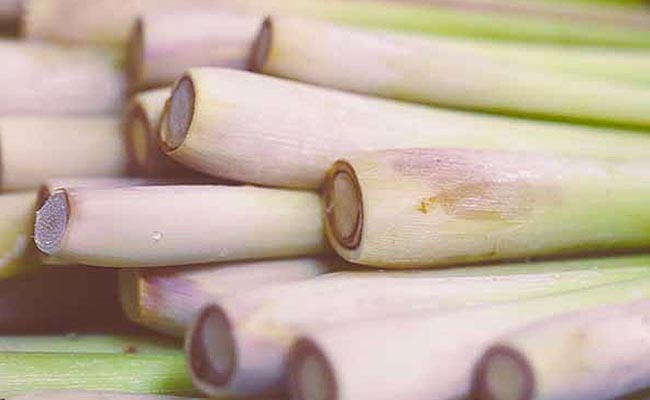There is nothing like growing your own lemon grass. It may not look like much, just a bunch of long tall green blades emerging from a dense clump but one whiff of this plant and you will be sold. Its a tropical perennial plant only hardy to zone 9 but easily grown in much of the United States as an annual and producing multitudes of delightful long lemon scented leaves. It looks great in pots on or next to decks or patios where it also serves to control insects with its powerful citronella content. The plant needs full sun and as hot a position as you can find. Does like some water, its reasonably drought tolerant but will need some water in a long drought. Its easy to grow and takes little maintenance once its established. Its also deliciously edible, the inner portions of the lowers stems can be eaten or added to sauces but the rest of the leaf can be made into refreshing tea. If you have a soda maker try using lemon grass tea for a refreshing summer experience. Its also used medicinally, as flavoring in so many foods and in cleaners, soaps and cosmetics an all round power house herb.
While lemon grass can flower it rarely does so above zone 10 and the flowers are not showy like regular ornamental grasses but are large loose panicles up to inches (60cm) repeatedly branched with small spiky looking brown flowers that can easily be overlooked.
Grasses grow rapidly and has a clumping habit with multiple stalks emerging from a single base the clump increases from the center outwards with thicker older stems in the center and thinner younger stems on the outside.
The only thing that distinguishes this grass from other clumping grass is the strong lemon aroma that emanates from the plant. The whole leaf has produces this sweet scent with the strongest being close to the base. Lemon grass can reach the height of 5-6 feet (1.8m) in a single season, it will die back to the ground in zones 8-9 but may continue as an evergreen in warmer zones. Above 8 it dies when subjected to cold.
Use good potting mix either in small pots or larger cell trays, plant seeds about 1/4 inch (5mm) deep and cover lightly keep moist and in a warm bright location seeds usually germinate within 1-2 weeks. When large enough transplant at about 3 inches (7.6cm) tall move to individual pots and grow on until gradually exposing the plant to more and more sunlight until it is totally acclimatized to the outside only then plant out. See our General Growing instructions for more information on growing from seed.
Soil. Lemon grass prefers a good rich soil with some organic material added. Incorporate this into the area where you are going to plant the lemon grass before you plant. The soil needs to be well draining and close to neutral in pH does not like excessive acid or alkaline soils and cannot tolerate heavy soils that hold too much moisture.
Water. Lemon grass seeds moisture so we recommend using a soaker hose and surrounding the plant with some kind of mulch to keep the moisture in the soil. the simplest is plastic, the sheets available at big box home improvement stores is ideal. lay on the ground and stake down, bricks or small twigs can be used if you cant get metal ground staples then cut a hole and plant the lemon grass there. Plastic can be cut back slowly as the plant increases in size and fills the hole. Ground cover fabric now available at many garden centers is ideal. Place the soaker hose UNDER the mulch layer so all water goes directly into the soil and does not evaporate this way you can use much much less water. Once established lemon grass can tolerate less water but if growing it for eating we recommend continuing to water so you can harvest on a regular basis.
Fertilizer. Provided the soil was amended before planting with good compost Lemon grass will only need a few light feedings of a good organic fertilizer every year. Those made from seaweed are excellent sources check your local garden center for liquid organic fertilizers.
Overwintering. In zones 10-11 the plant may stay green all year long and even flower. Cut back all brown stalks and keep the plant tidy. Harvesting can continue all year long and will keep the plant in check from overgrowing its location.
In zones 8-9 the plants may die back to the ground over the winter, so cut all the stalks down and place a layer of mulch over the top to help protect it during the winter months. Chopped leaves are an ideal mulch but in windy areas netting or something like it may be needed to keep the mulch in place. Ensure you use something that will not trap wild animals and birds.
For all other zones there are two choices.
1. Just let your plant die, and treat it only as an annual. Since plants can grow large in one season this many be enough.
2. Plant your lemon grass in pots OR dig up and transfer to a pot for the winter. The latter can be a challenging issue digging out large ornamental grass clumps can be tough so growing in a large pot to begin with is best unless you want a physical challenge.
Choose large pots at least 2 feet (61cm) across more if desired. Pots don't have to be very deep so ones about 2 feet (61cm) deep is sufficient and keeps down the weight. We recommend wide based pots rather than those that taper down to a more narrow base as this ensures that they wont blow over in a windy conditions. Fill pots with a mixture of some soil and good potting mix and about 20% compost from whatever is your best source. Plant a single grass seedling in the pot and place in a hot sunny location. Water daily as pots dry out rapidly. Plants will rapidly expand to fill the pot and grow up to 6 feet (1.8m) tall.
Plants cannot tolerate temperatures below 50 F (10C) so as nighttime temperatures drop the plants will need to be brought inside for the winter months. There are two main options.
1. If you have sufficient room in your home placing the pot (with a large drainage saucer) in your home close to a south facing window will keep the plant alive and thriving during he winter months and also allow you to continue harvesting the stalks. Water regularly once or twice a week is usually sufficient. Plants can be heavy so use a wheeled platform or dolly to move the plant into place. Do not attempt to pick it up you may injure yourself.
2. Overwinter pots in more dormant state. These pots will need to be stored in an area that does not drop below 50 F (10C) if unsure use a thermometer to check the Nighttime temperature of the location you are considering. If suitable plants can be cut down the soil level and stored away from light. If pots are not too heavy and have strong rims they can even be stacked using sections of wood as cross braces to ensure one pot stands only on the rim of another and does not put weight on the plant inside the pot. Don't try and lift heavy pots if they are too heavy store separately. These pots need to be kept just moist so the plants don't dry out. Store until temperatures rise again outside the replace and continue to use your lemon grass once again.
If you don't have room for the whole plant inside you can always break a small portion of the plant off and pot that up for winter use. You will need some strong tools to do this as roots tend to be very strong. dig down in one section of the lemon grass plant then using a large knife, machete or (most likely) the blade of a spade chop a section of the plant off and then repot this to bring inside. Gives you a much smaller and more manageable section of plant to deal with. Always cut the section of plant from the outside of the lemon grass clump. these will be the younger stems and will survive the longest. Clumps grow from the center out and eventually the center dies so those on the outside will live longer.
Harvesting can begin when the plants reaches 12 inch (30.4cm) tall and base of the stem is about 1/2 inch (1.2cm) thick stalks can be used most of the way up the leaf leaving only the ragged curled section at that top. Flavour is stronger at the base but just as good for teas and flavouring in the green leaf.
When growing as an annual it is unlikely that stems will reach the large fat size you see in grocery stores. These stems come from mature tropical plants that are 2-3 years old not annual plants. Once chopped up and used for whatever culinary delight you desire its not noticeable. While some sources state that the inside portion is like 'soft butter' this state is not found in smaller leave only those over 1/2 inch (1.2cm) diameter. The longer you leave the stalk to develop the more soft material you may obtain.
The advantage of growing your own lemon grass is the flavor can be more intense even in small stems because the supermarket bought stalks have been drying out for a considerable time before you purchase them. Home grown is fresh from the ground with all its flavour intact.
Use very strong scissors or plant snips to harvest stems they can be hard to cut. We recommend using gloves as the edges of the long leaf blades can be very sharp and inflict nasty cuts. (They are called blades for a reason).
Cut only a few stalks at a time. Do not cut all the stalks from one plant. While this most likely wont kill it but will set back its development, reduce future harvests and the time between harvests.
The inner section of the grass stem can be cooked an eaten as a vegetable. Stems need to have the outer section removed down to the white core and this is steamed then usually eaten with rice but are also added to sir fries, salads and sauces. Older stems and leaves are more fibrous and are used only as flavouring. They can be used in small bags during cooking to impart flavour and removed before eating. This is used to flavor rice, soups, stews curries as a marinate.
Leaves can also be used to make a refreshing tea.
Lemon grass 'hearts' can be frozen for later use. Peal stalks then slice thinly and freeze in single layers between plastic so you can later select as much as you need for a particular dish. It can also be froze minced or pureed.
It can also be dried then sealed in air tight jars for later use in flavouring or as a tea.
Take care to experiment with your fresh lemon grass it often has a stronger flavour than shop bought varieties which has been drying out since it was harvested, this could have been a week or more ago and during that time many compounds can be lost. Fresh lemon grass contains a full compliment of compounds and can be stronger even if the stem is thinner. So add less to your dish and taste first.
Warning. Pets ,commonly cats and dogs, can develop stomach issues if they are fed lemon grass.
An essential oil is extracted from the plant and this is used mostly externally. It has strong anti fungal and anti bacterial properties and is inhaled to help treat colds, flu, muscle pain, athlete's foot, ringworm, lice and scabies. there are also some reports that rubbed into the scalp it can help reduce dandruff.
A diluted form of the oil can be rubbed on the skin to help with headaches and musculoskeletal and arthritic joints pain as well as sciatica, sprains, tendinitis, neuralgia, and rheumatism. The oil appears to help increase circulation and blood flow. Never use undiluted essential oil on skin it can burn it.
The essential oil contains about 70% citral, plus citronellal making it a fairly strong insect repellent but also a mild sedative so take care to use sparingly.
Fragrance. The lemon scent is much in demand in the perfume industry and for scenting soaps, hair oils and cosmetics.
Cleanser. Personal. The essential oil can be mixed with other ingredients to help cleanse oily skin and close pores, mixed into shampoo it can help combat greasy hair, also as a deodorant to help reduce bacteria. Never use undiluted essential oil on skin it can burn. It is used extensively in soap making as well as many beauty products.
Cleanser - Home. Many organic household cleaning products include lemon grass oil, it can be mixed with vinegar and water to produce a multi purpose cleaner.
As flavouring in most major food categories including alcoholic and soft drinks.
In zones where it grows as a perennial it is sometimes used for erosion control as its tough roots hold soil together binding it in place. Excellent on poor soils in well drained areas. Produces many grass stalks that die back and decompose increasing soil quality and sequestering carbon and increasing soil quality.








